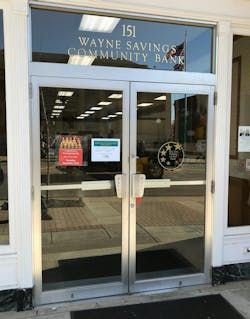Durable doors like Tubelite’s often outlast the usage conditions or code requirements for which they were originally installed. When that happens, they can be modified to meet the new needs and go on performing for decades more. Pat Neyhart, vice president of Wooster Glass Co. in Wooster, Ohio, knows of several such doors. He started with the company in 1969 while he was still in high school and, except a brief hiatus to attend college, has worked there over 40 years. Wooster Glass installed the doors of the Wayne Savings Bank when it opened in 1964, and those doors are still in operation today.
“Those are the original doors for the bank. It’s got the custom push-pulls. We’ve never taken it off or had to replace a tie rod or anything. I cannot remember having anybody go up there to service that door,” says Neyhart. “I’m guessing it has to open and close at least 75 times a day. That door is as original as you can get. They could even be the original hinges. Hinges get a lot of use, and sometimes you have to replace them, but it’s pretty easy on a Tubelite door.”
Another Wooster installation, 116 East Liberty Street, is a retail location that has had many lives over the past 40 years, but like the bank, only one set of doors. They are Tubelite narrow-stile standard doors with a clear anodized finish. When they were installed in the 1970s, the location was Brenner’s Clothing Store. The mosaic floor of the entryway still says “Brenner Bros” to this day.
Neyhart recalls that when it became a coffee shop, code required a panic bar exit device on one door. He explains that it was a fairly simple modification: “You take the two tie rods off and replace the rails. You can manually disassemble the tie rods manually, without power tools, and do it right in the field.”
The current tenant of the location, the Blue Spruce Boutique, reports that the doors are still performing well.
Neyhart observes that easy modification and repair is an important feature of tie-rod assembled doors, because they save the owner significant money. “If someone tries to break into a building, they’ll destroy the lock-stile,” he says. “You can take off that horizontal rail and replace it, and you’re back in business. Or if a car hits it, you can replace a couple of horizontal rails and some glass and repair the door. If it’s some other welded door, you’d have to order a complete new door. Tie rod definitely has its advantages.”
“We prefer to use Tubelite because of the adaptability,” says Neyhart. “For repairs, or if something gets fabricated incorrectly (sometimes we might put the closer on the wrong side, or drill a hole in the wrong place) we can just replace that rail. If it was a welded door, it would be a whole different story—you’d have to replace the entire door. We like the adaptability of tie-rod doors so much better. The beauty is the adaptability and the ability to change.”
